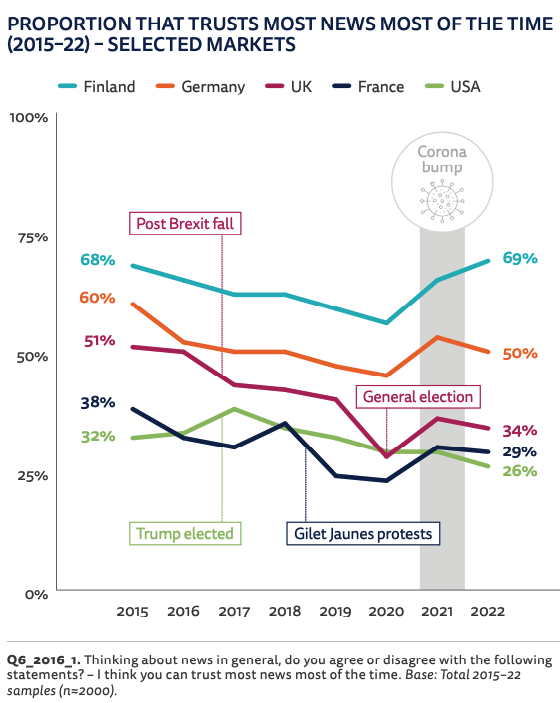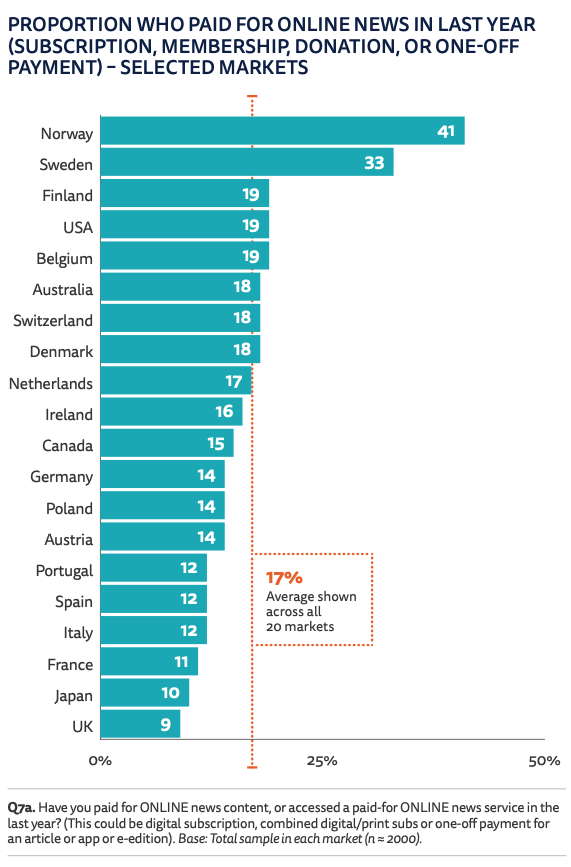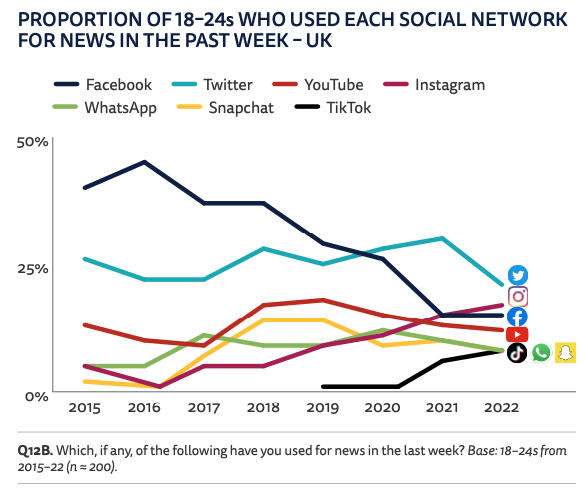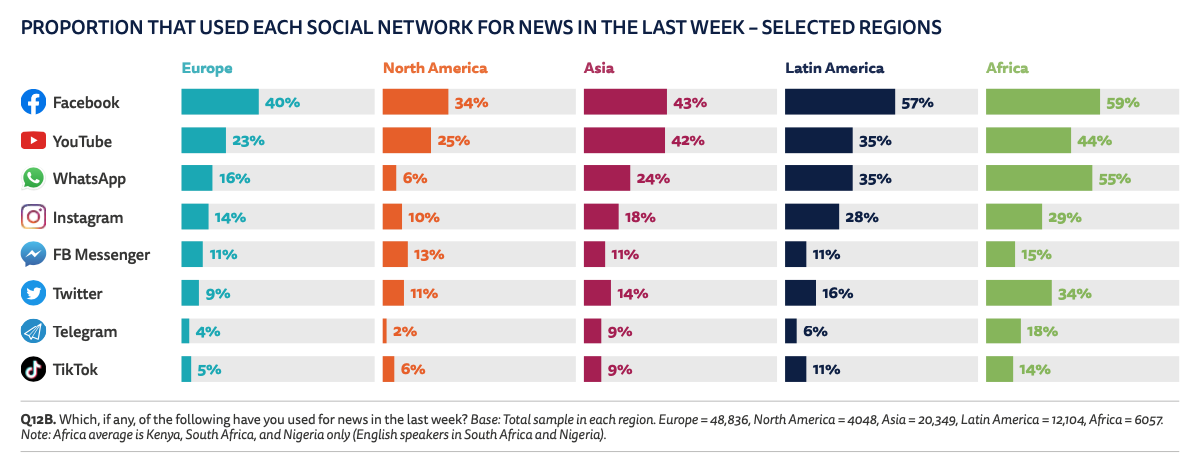Last week, the Reuters Institute for the Study of Journalism at the University of Oxford published its annual Digital News Report.
Now in its tenth year, the report is essential to make sense of the attitudes and behaviors of news consumers around the world. Findings in the latest report stem from a survey of more than 90,000 digital news users in 46 countries across five continents.
Featuring profiles of each market, as well as a comparative analysis covering some of the biggest countries, the study is packed with data that newsrooms can use to inform their evolving digital strategies.
Over the past decade, these reports have heralded trends in online news consumption - including the shift to mobile and the growing importance of social media. Alongside these major trends, studies have also highlighted emerging issues in journalism, such as the rise of misinformation, trust in journalism and the news habits o f younger audiences.
Against that backdrop, here are five essential — and potentially overlooked — findings from this year’s report:
1. Trust in the news is highest in Finland
Finland remains the country with the highest levels of overall trust (69%) in the news.
This is up four points from 2021 — and 13 points since 2020. This makes Finland one of only two other markets where more than 60%of the sampled population indicated that they “trust most news, most of the time,” the others being Portugal and South Africa.
On average globally, only around four in ten survey respondents (42%) said that they trust most news most of the time. Trust is lowest in the U.S. and Slovakia (both at 26%), followed by Taiwan and Greece (27%).

2. The average age of a digital news subscriber is almost 50 years old
Getting younger audiences to take an interest in the news, never mind paying for it, is a huge challenge for media outlets today.
This problem was made clear through the findings that indicated that the average age of those paying for digital news is 47 years old. In the U.S., only 17% of news subscribers are under 30, and only 8% in the U.K..
However, the percentage of young subscribers in the U.S. also matches the average across the 20 countries where payment for news is relatively widespread. Norway continues to be the global leader for digital news payments (41% of users paid for online news content in the past year), followed by Sweden (33%), Finland (19%) and the U.S. (19%).
Of potential concern is the observation that when it comes to the continued growth of those willing to pay for news, “longer term trends do suggest a slowing down in some of these early-mover markets — raising questions about whether they might be reaching a more mature phase.”

3. Younger audiences really do consume news differently
The report’s data indicated that younger audiences are more likely to intentionally avoid the news. They are also less attached to news brands due to the popularity of accessing news content via “side-doors,” such as social media, search engines, and mobile aggregators.
Young people are also less wedded to concepts of journalistic impartiality, in part due to growing up in the world of the social, participatory web. At the same time, the report notes that “wariness of bias at times pushes [young people] away from consuming news altogether.”
Across all markets, 15% of adults ages 18-24 use TikTok for news, which is 3% higher than it was in 2020. More generally, TikTok is used by 40% of this age group in 46 countries.

4. YouTube is more popular for news than you may realize
More than half of digital news consumers in the Philippines (57%), Thailand (55%) and India (53%) use YouTube for news in a typical week.
One reason for this is that some consumers prefer video news. Another factor might be the contrast — in terms of style, tone and content — with more traditional media channels. For example, the report notes that in Thailand, “the combination of low data charges, and greater freedom to speak openly online, has led to a spate of independent TV-style shows that are widely consumed on mobile phones.”
YouTube can also be a popular platform for podcast consumption. Video-led podcasts are part of this equation, as is the ability to have YouTube on in the background while multitasking. YouTube is the most popular channel for podcast consumption in Spain (30% of monthly podcast listeners) and the second most popular (19%) in Germany.
Collectively, YouTube’s global reach for news — especially when compared with more traditional platforms for news distribution — suggests that having a comprehensive YouTube strategy might become a development goal for news organizations.

5. Email news is probably less popular than you think
Just as YouTube’s popularity as a news channel is understated, it’s possible that the importance many newsrooms have placed on email and newsletters in recent years has been overstated.
Although newsletters can be a key gateway to driving subscriptions and promoting regular engagement with audiences, fewer than one in five (17%) digital news users get their news via email in a typical week. Those that do tend to be older, better educated and typically more engaged with the news cycle than the average consumer.
Among those who use email as a source for news, reasons include convenience (65%), range of stories (30%) and the tone/style deployed (24%). Authorial voice, which in newsletters can often be quite different from other channels, was highly valued in markets such as India (55%) and South Korea (40%).
This tone of voice can be seen in the rise of platforms such as Substack. However, the paid–newsletter market remains small. In the U.S., 7% of news subscribers pay for an email newsletter, dropping to as little as 1% in Germany and Australia.
Moreover, in the U.S., while the total number of news newsletters being published has grown substantially, its total audience has in fact declined.

Photo by Campaign Creators on Unsplash.


